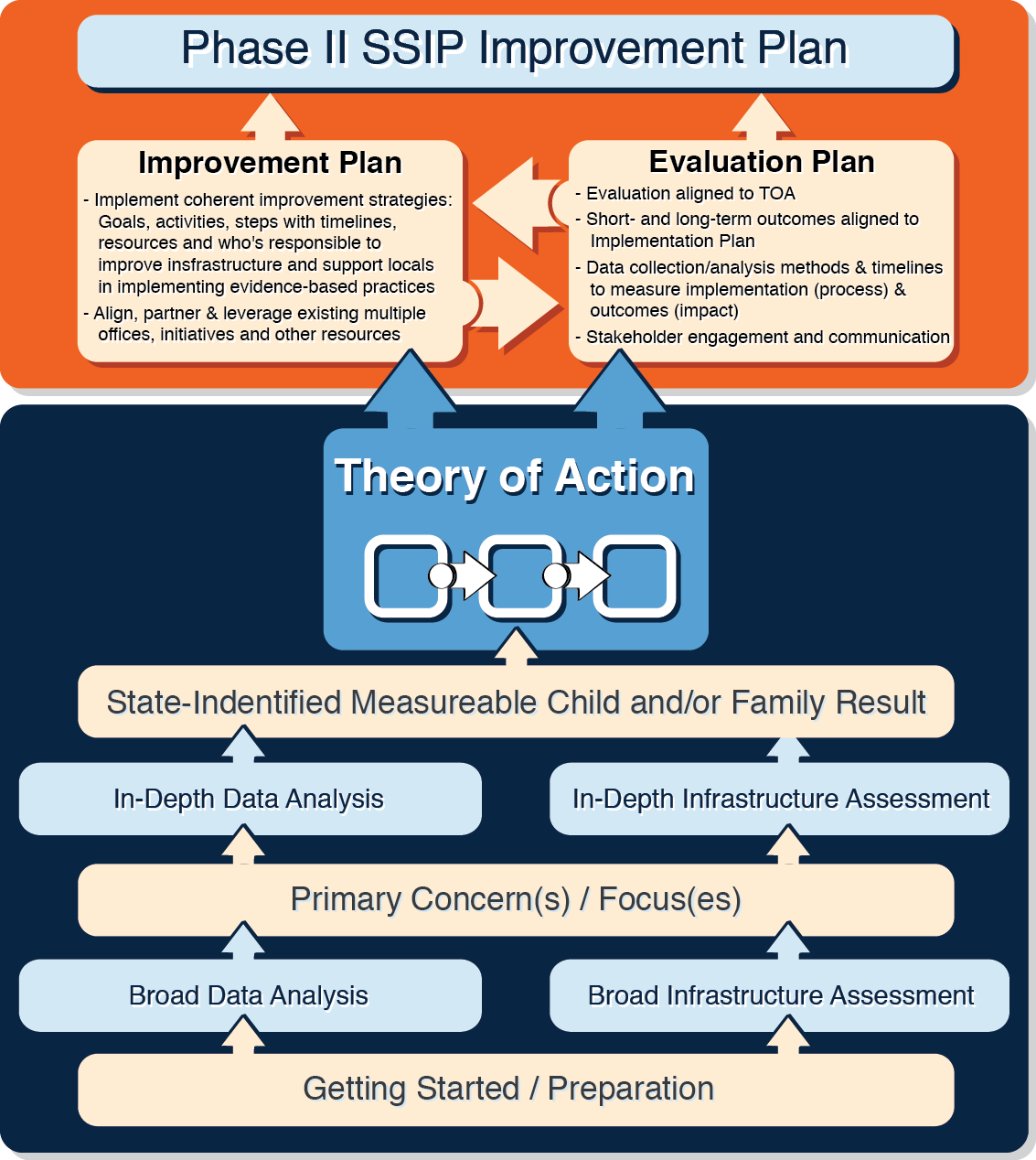SSIP Phase II Process Guide
The online version of this guide is available at: https://ectacenter.org/topics/ssip/ssip_phase2.asp
The Part C State Performance Plan (SPP) and Annual Performance Report (APR): Part C Indicator Measurement Table describes the focus of the SSIP Phase II–Plan as:
"The focus of Phase II is on building state capacity to support Early Intervention Service (EIS) programs and/or EIS providers with the implementation of evidence-based practices (EBPs) that will lead to measurable improvement in the State-identified Measurable Result(s) (SIMR) for infants and toddlers with disabilities and their families."
The Part C State Performance Plan (SPP) and Annual Performance Report (APR): Part C Indicator Measurement Table (subsequently referred to as the Part C Indicator Measurement Table) defines three components which must be included in the April 2016 submission of the SPP/APR Indicator C-11 and B-17, the State Systemic Improvement Plan (SSIP) including:
- Infrastructure Development;
- Support for EIS Programs and/or EIS Provider Implementation of Evidence-Based Practices; and
- Evaluation
The SSIP Phase II Process Guide describes the steps needed to accomplish the work of the three components of Phase II. Thus, the SSIP Phase II Process Guide is organized according to the following sequential phases of work to be done, rather than by the three components.
- Kicking off Phase II
- Developing the improvement plan
- Developing the evaluation plan
- Communicating the plan
Throughout The SSIP Phase II Process Guide the term “the plan” refers to the set of activities, steps, and resources described in the Part C Indicator Measurement Table.
The three components are included throughout the sections of the SSIP Phase II Process Guide.
Figure 1: The components included in Phase I and Phase II of the SSIP and the connection between the Phases

Figure 1 shows the link between Phase I–Analysis and Phase II–Plan and the connections among the components of Phase II. Phase II should be integrally connected to Phase I–Analysis and Phase III–Implementation and Evaluation. The theory of action (ToA) developed in Phase I will drive Phase II and lay out the work to be completed in Phase III. Many states are taking steps to install some of the system changes, like enhancements to the professional development system, that are most critical to supporting the improvement strategies identified in the SSIP. Although these implementation activities are required under Phase III and not Phase II, beginning to install them early in the process may be critical to meeting future timelines. States also are likely to make changes to the Phase I ToA and improvement strategies, in order to align the work to the most recent knowledge of state strengths, challenges, and capacity, and they will need to document the reasons for these changes. As states begin the installation of activities to improve the infrastructure in Phase II, they should track the activities, including the start date and progress, to ensure that they can accurately report and evaluate all activities they completed under the SSIP.
Timeline for Submission to OSEP
Figure 2 shows the timeline for submission of each Phase of the SSIP to OSEP and provides a brief description of the content included in that Phase.
Figure 2: Timelines and Descriptions of Each Phase of the SSIP, adapted from the Part C Indicator Measurement Table
Year 1 – FFY 2013 Delivered April 2015
Phase I: Analysis- Data Analysis
- Description of State Infrastructure to Support Improvement and Build Capacity
- State-identified Measureable Result (SIMR)
- Selection of Coherent Improvement Strategies
- Theory of Action
Year 2 - FFY 2014 Due April 2016
Phase II: Plan Multi-year plan addressing:- Phase I Content/Updates
- Infrastructure Development
- Support for EIS Program and/or EIS providers in Implementing Evidence-Based Practices
- Evaluation Plan
Years 3-6 - FFY 2015-18 Due February 2017- 2020
Phase III: Implementation and Evaluation Reporting on Progress including:- Phase I and Phase II Content/Updates
- Progress toward short- and long-term outcomes
- Revisions to the SPP and evaluation data to support decision
States submitted Phase II SSIPs using a process similar to that used for Phase I according to OSEP requirements.
Stakeholder Engagement in Phase II
In the Part C Indicator Measurement Table OSEP stressed the importance of stakeholder engagement throughout the SSIP process. Some considerations related to engaging stakeholders in kicking off the Phase II plan include:
- Reengage stakeholders to the work of Phase II based on the status of Phase I of the SSIP and the purpose of the SSIP.
- Use multiple opportunities and formats (e.g. websites, newsletter, state conferences) to share information about the development of Phase II of the SSIP with stakeholders and create opportunities with stakeholders so they can share information with their communities.
- Consider the "messaging" for the participating local programs. Are the messages co-created? How will the state garner their support? If the state selected subsets of programs having low performance to achieve the SIMR, how will the state garner programs' support without focusing on the negatives that prompted their inclusion in the state’s efforts?
- If the state uses planning or implementation teams, engage stakeholders not included on these teams in a discussion about how they would like to get information, provide input into planning, and discuss potential implications for future learning.
